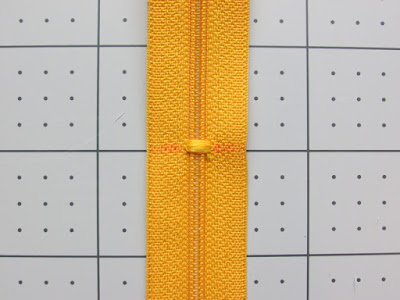I love the look and ease of an outfit that uses a zipper for the closure. Sewing a zipper may sound intimidating at first, but they really aren't that bad if you use the method I do! It's basically just pinning in place and sewing a few straight lines! So let's say you're ready to start your first zipper project. The first step is to BUY the zipper, right? The pattern you're using will tell you what kind of zipper to buy and how long it needs to be. No problem. But what happens when your pattern calls for a 10" zipper but all you can find are 8" or 12" zippers?
Can you make one of those sizes work or do you have to keep searching?
Can you make one of those sizes work or do you have to keep searching?
Well, today we have an easy answer and solution to that problem! The great thing about zippers is that you can always buy a longer zipper than you need and just shorten it! So the answer to the question above, is that you would want to buy the longer zipper. A 12" zipper can easily be shortened to 10", but an 8" zipper cannot magically get longer. Got it?
There are different kinds of zippers, of course. Dresses usually use standard closed-end zippers, where the zipper stays together at the end. On the other hand, jackets or coats usually use a "separating" zipper that comes apart at the end. Both types can be shortened, but there is an important difference. Separating zippers must be shortened at the top, while dress zippers are better shortened at the bottom. I will show you both today!
I will start by demonstrating how to shorten a standard dress zipper using just a sewing machine and scissors. It's super easy! Here goes:
First lay out your zipper. Starting at the top of the zipper teeth, measure down how long you want your zipper to be and then mark a line across the zipper at that point.
In the example above, I measured down 10" and marked it in red.
Take the zipper to your sewing machine. Center the zipper under your machine foot, directly at the line that you marked. The zipper teeth should be going right down the center, as shown above.
Set your machine to do a zigzag stitch. Then set the stitch as wide as it will go, with the length set as short as it will go. (You want it to sew back and forth widely, while barely moving forward, if at all.) If you don't know how to shorten your stitch, you can also lower your feed dogs so there's no forward movement at all.
Now check to make sure your zigzag stitch goes wide enough to straddle your zipper teeth. Most dress zippers fit easily between the zigzag stitches, but you want to double check anyway to prevent a broken needle. To check, use your hand crank to lower your needle to one side of the zipper and then the other, without moving the foot or the zipper at all.
After you know your zigzag can straddle the zipper, go ahead and sew the zigzag stitch back and forth until it builds up a mound of stitches. (If you did not lower your feed dogs, sew a few stitches forward and then reverse to do a few stitches backward. Repeat many times.)
Sew stitches back and forth until they form a bar tack, or mound of stitches, that can completely stop the zipper. It should look something like the photo above.
Unzip the zipper to make sure the new stopper you made is good enough to stop the zipper.
If it's good, trim the zipper below the stitches, leaving about 1/2" to 3/4" below it. See photo above.
That's it! Your zipper is now ready to be used on your project!
Now, let's say your zipper teeth were too wide to sew across with your zigzag stitch? You have a couple options. You can sew the stitches by hand with a needle and thread, sewing across the teeth as shown above, until you form a stopper with the threads. Or, you can use another method, such as moving the stopper with pliers (metal) or melting a new one (plastic). Those techniques aren't my first choice but they do work! And in some cases they are better for separating zippers too. We have a video below to demonstrate both those methods.
But first, I want to say that you can use the same method I showed you above on a separating zipper too -- the only difference is that you need to mark the zipper and sew the new stoppers at the TOP of the zipper instead.
Just in case that isn't clear, we made a video to show all these techniques on a separating zipper. Nikki and her husband joined in too, to help show you several ways to choose from, depending on your project and resources. Here's that video. Enjoy!
https://youtu.be/iuugU4r1AVI
Wasn't that helpful? Now you can see lots of different ways to shorten a zipper! While we wanted this to be comprehensive to fit all the scenarios you might come across, keep in mind that it really only takes less than a minute to actually shorten the zipper. It's super easy and you'll be a zipper-sewing pro in no time!
If you have any questions, be sure to come ask us in our patterns group on Facebook! We love to help.
Let's Create! ~ Kristen






